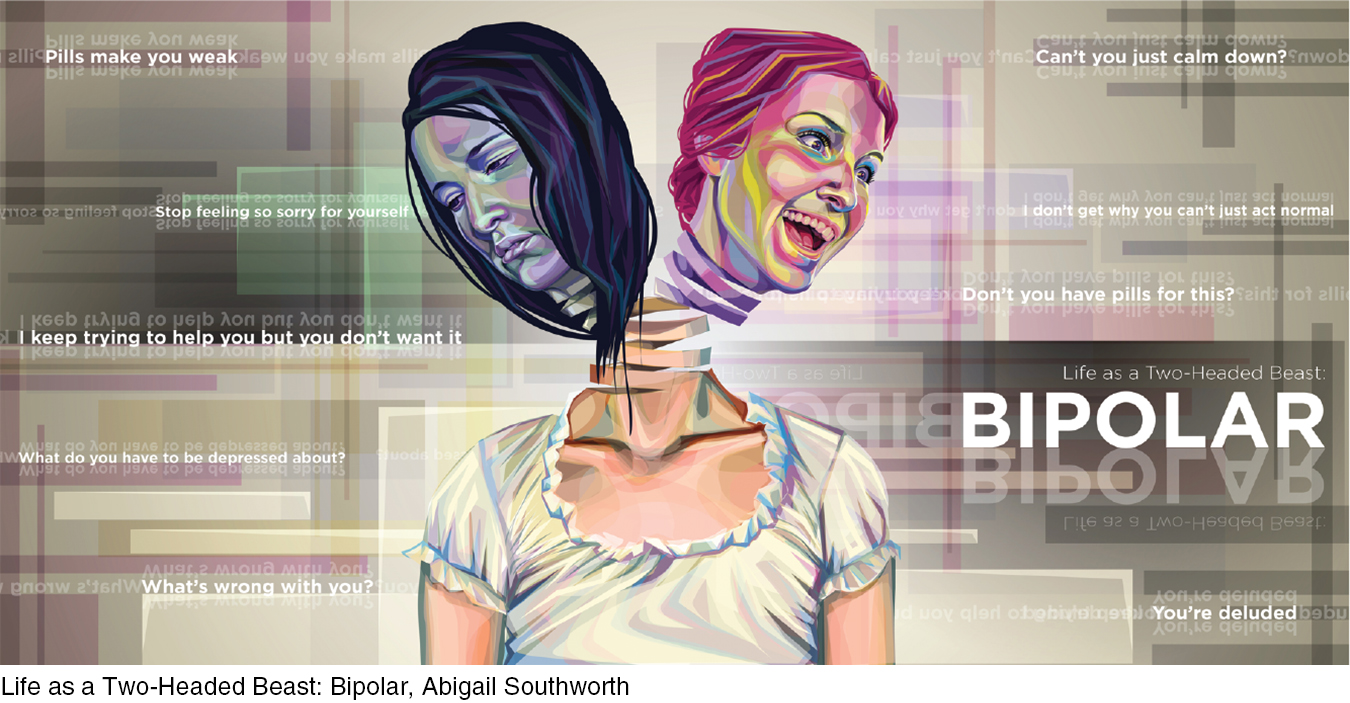42.2 Bipolar Disorder
bipolar disorder a disorder in which a person alternates between the hopelessness and lethargy of depression and the overexcited state of mania. (Formerly called manic-depressive disorder.)
mania a hyperactive, wildly optimistic state in which dangerously poor judgment is common.
Our genes dispose some of us, more than others, to respond emotionally to good and bad events (Whisman et al., 2014). In bipolar disorder, people bounce from one emotional extreme to the other. When a depressive episode ends, a hyperactive, overly talkative, wildly optimistic state called mania follows. But before long, the elated mood either returns to normal or plunges again into depression.
If depression is living in slow motion, mania is fast forward. During mania, people typically have little need for sleep. They show fewer sexual inhibitions. Their positive emotions persist abnormally (Gruber, 2011; Gruber et al., 2013). Their speech is loud, flighty, and hard to interrupt. Feeling extreme optimism and self-esteem, they find advice irritating. Yet they need protection from their poor judgment, which may lead to reckless spending or unsafe sex. Thinking fast feels good, but it also increases risk taking (Chandler & Pronin, 2012; Pronin, 2013).
In milder forms, mania’s energy and flood of ideas fuel creativity. Clusters of genes that predict creativity also increase the likelihood of having bipolar disorder (Power et al., 2015). George Frideric Handel (1685–1759), who many believe suffered from a mild form of bipolar disorder, composed his nearly four-hour-long Messiah during three weeks of intense, creative energy in 1742 (Keynes, 1980). Bipolar disorder strikes more often among those who rely on emotional expression and vivid imagery, such as poets and artists, and less often among those who rely on precision and logic, such as architects, designers, and journalists (Jamison, 1993, 1995; Kaufman & Baer, 2002; Ludwig, 1995). Indeed, one analysis of over a million individuals showed that the only psychiatric condition linked to working in a creative profession was bipolar disorder (Kyaga et al., 2013).

Bipolar disorder Artist Abigail Southworth illustrated her experience of bipolar disorder.
Life as a Two-Headed Beast: Bipolar, Abigail Southworth

Creativity and bipolar disorder There have been many creative artists, composers, writers, and musical performers with bipolar disorder.
Dave Bedrosian/ZUMA Press/Newscom; George C. Beresford/Hulton Getty Picture Library; The Granger Collection, NYC—All rights reserved.
Page 547
Bipolar disorder is much less common than major depressive disorder, but it is often more dysfunctional. It afflicts as many men as women. The diagnosis has been on the rise among adolescents, whose mood swings, sometimes prolonged, vary from raging to bubbly. The trend was clear in U.S. National Center for Health Statistics annual physician surveys. Between 1994 and 2003, bipolar diagnoses in under-20 people showed an astonishing 40-fold increase—from an estimated 20,000 to 800,000 (Carey, 2007; Flora & Bobby, 2008; Moreno et al., 2007). Americans are twice as likely as people elsewhere to have had a bipolar disorder diagnosis (Merikangas et al., 2011). Under the DSM-5 classifications, the number of child and adolescent bipolar diagnoses (two-thirds boys) will likely decline: Some individuals with emotional volatility will now be diagnosed with disruptive mood dysregulation disorder, a new DSM-5 diagnosis for children “who exhibit persistent irritability and frequent episodes of behavior outbursts three or more times a week for more than a year” (Miller, 2010).

